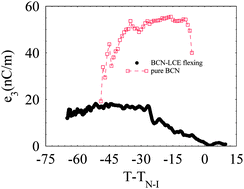Flexoelectricity of a calamitic liquid crystal elastomer swollen with a bent-core liquid crystal
Abstract
We have measured the electric current induced by mechanical distortion of a calamitic liquid crystal elastomer (LCE) swollen with a low molecular weight bent-core nematic (BCN) liquid crystal, and have determined, for the first time, the bend flexoelectric coefficient e3 of such a BCN-LCE composite. In one method, we utilise air-pressure to induce a mechanical bend deformation and flexoelectric polarization in a BCN-LCE film, and then measure the polarization current as a function of time. An alternative technique uses a rotary-motor driven scotch yoke to periodically flex the BCN-LCE; in this case, the magnitude and phase of the induced current are recorded via a lock-in amplifier. The flexoelectric coefficient, e3, was found to be ∼20 nC/cm2, and is stable in magnitude from room temperature to ∼65 °C. It is about one third the value measured in samples of the pure BCN; this fraction corresponds closely to the molar concentration of BCN in the LCE. The flexoelectric current increases linearly with the magnitude of the bend deformation and decays with frequency. These observations indicate a promising way forward towards producing very low-cost, self-standing, rugged electromechanical energy conversion devices.


 Please wait while we load your content...
Please wait while we load your content...